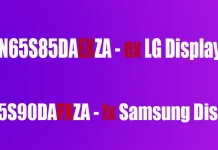Modern Hisense TVs, are equipped with many features to help you get the best experience from your video content and only make it easier to watch. For example, you can easily enable or disable subtitles, voice assistant, adjust shadows and brightness, and more to make watching comfortable for you. This is especially true for people who watch original content from different countries in a foreign language.
Subtitles help you view content, but of course, along with that they sometimes get in the way because if you don’t need them, subtitles take up a significant portion of the screen. Nevertheless, if you need subtitles on your Hisense TV, you can easily enable them. And here’s how you can do it.
Why do you need to use subtitles?
When a new film comes out, it’s not easy to get it translated. It’s even harder to get it dubbed in the native language, so new films are often subtitled first and only then dubbed. Although many movie lovers prefer to see films in their original language to feel the emotions and actions. Some people improve their foreign language skills because there is no better practice than listening to native speakers.
Also, subtitles are the only option for people with hearing problems. Finally, subtitles can be present as a way to duplicate television programs in the national language.
Subtitle control on most modern TVs, including Hisense TVs, is as simple as possible. Using the remote control buttons, you can change the status of the screen with a few taps. For example, you can easily turn on subtitles on your LG TV as well. However, the problem is that, firstly, many people simply don’t know about this possibility. Secondly, there’s no generally accepted standard on this issue, and each manufacturer solves the problem in its way.
Read Also:
- How to change the input source on Hisense TV without remote
- How to turn on Demo Mode or Store Mode on Hisense TV
- How to connect Hisense TV to Wi-Fi
How to enable subtitles on Hisense TV
If you need subtitles to watch your favorite movies or series and learn a foreign language, or if you’re not able to hear, you can easily turn on subtitles on your Hisense TV. To do this, you have to follow these steps:
- First of all, press the “Subtitles” or “CC” button on your Hisense TV remote control.
- A window with the title “Subtitles” will open.
- Finally, just click on the “ON” button using your remote control arrow key.
Once you have completed these steps, you will be able to turn on subtitles on your Hisense TV. Moreover, you can also watch Hulu on your Hisense TV.
At the same time, almost all services provide the possibility to have access to subtitles. Since there can be many situations when you need it. Twitter’s closed caption toggle is now available on iOS and Android, this will make using the social networking site most convenient. That’s why subtitles can be useful.
How to change the language of the subtitles on Hisense TV
By the way, your Hisense TV also allows you to change the language of the subtitles. If you want to do this, you have to follow these steps:
- At first, press the “Quick Menu” button on your Hisense TV remote control.
- Then, scroll through the menu and go to the “Settings” section.
- After that, navigate to the “System” menu and press “OK”.
- Next, select “Language and Location”.
- Now, once you have reached the “Primary Subtitle” window, just press “OK”.
- Finally, select your desired language and press “OK”.
Once you have completed these steps, you will be able to change the language of the subtitles on your Hisense TV. Furthermore, you can also easily disable subtitles on your Hisense TV.
How to turn on subtitles on Hisense TV without remote control
If your remote control is broken and you can’t use it as always, and you need to disable subtitles on your Hisense TV, you can do it without the remote control. So, here’s how:
- You need to use the back of your TV, start by turning it on.
- Then, press the “Menu” button.
- After that, the list appears on the screen, and select the “Subtitle” option.
- Finally, use the arrow buttons to drag the slider to “ON” is displayed.
In this situation, the most important thing is that you have access to the back of your TV so that you can follow these steps. Once you have completed these steps, you will be able to see the subtitles while watching your Hisense TV. In almost the same way, you can control the volume on your Hisense TV without a remote control.
What is the difference between open and closed captions?
Subtitles are either open or closed captioned. The former is encoded in the video, while the latter exists as a separate file. The open ones are always on the screen and are an integral part of the movie or TV show. They are also called “hardcoded” or “stitched”.
Hidden subtitles can be turned off. They’re added to the video stream as text or images. A separate type of subtitles is pre-rendered subtitles which are encoded as images. They are used on DVD and Blu-ray.
Open captioning doesn’t require any special equipment or technology as the only requirement is for the client device to be able to play the video. However, for closed captioning, you need a player with the right format.
Read Also:
- How to turn on subtitles on Samsung TV
- Does Hisense TV have Bluetooth
- How to change the source on Hisense Smart TV
What’s the use of subtitles?
Watching films in a foreign language with subtitles can be very useful when learning a language. You have the opportunity to listen to native speakers and try to catch intonations and pronunciation. And if you don’t understand something in the dialogues, subtitles are a great helper, because you can immediately and quickly find out what it’s all about.
Besides, it’s a good way to study new vocabulary, because unfamiliar words can be put into your vocabulary, and later you can find their translation and memorize it. And agree, no matter how professional the voiceover is, it’s always more pleasant and interesting to listen to the real voice actors, rather than dubbing.
However, subtitles can be useless if they are misused, i.e. used inappropriately. It is always important to remember that the text at the bottom of the screen serves only as an aid to watching the movie. You must concentrate your attention, that is, draw it primarily to the listening, in other words, practice listening skills. Agree that you won’t listen carefully to the dialogues or the actors’ lines if your eyes are “glued” to the subtitles.






